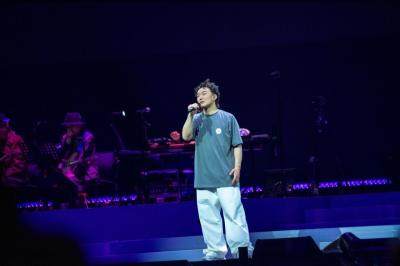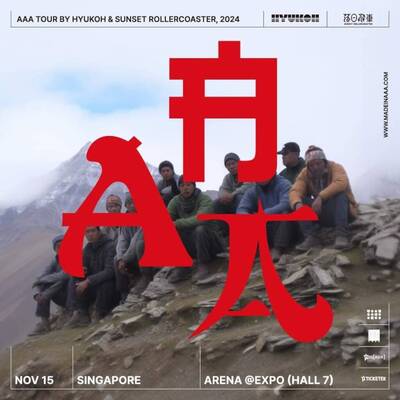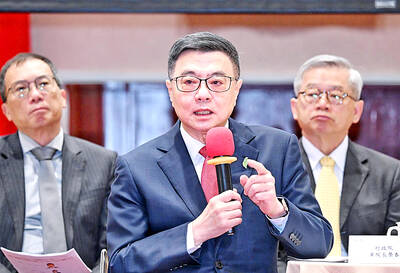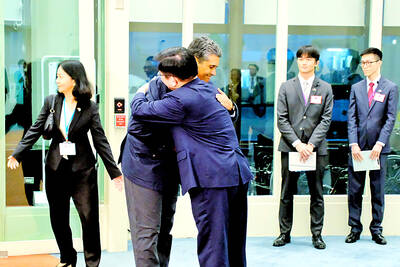When the prestigious US-China Economic and Security Review Commission recently suggested that Washington "conduct a fresh assessment of the `one China' policy" in view of changes over the past several years on both sides of the Taiwan Strait, the commission said little about what was on its mind.
Chairman Roger Robinson said the commission was not advocating a wholesale change in the policy or a recognition of Taiwan as a de jure independent state. But neither he nor the panel's annual report to Congress laid out in what way the group envisioned changes to the "one China" policy.
The reason is that the commission members who wrote the report were fundamentally split on the "one China" issue with some personally in favor of all-out recognition of Taiwanese independence, others taking a diametrically opposed stance and yet others urging caution.
"There was a big argument of how to phrase every paragraph," one commission member said.
In favor of a major change in the policy were Robinson, commission vice chairman Richard D'Amato, University of Miami professor June Dreyer and, to a lesser extent, former House Democratic aide Michael Wessel, according to commission sources.
On the other end of the spectrum was former US Commerce Department trade official Patrick Mulloy, who wrote a separate opinion defending the existing "one China" policy and arguing that the US does not have a legal obligation to defend Taiwan militarily.
The commission made three specific recommendations: that the "one China" policy be reviewed for its "successes, failures and continued viability," that the US' defense coordination with Taiwan be reviewed, and that ways be found to help Taiwan break out of its China-imposed international isolation.
It also urged the administration to unlock any secret assurances made to China and Taiwan over the years that could bear on the review, and that the US find ways to promote cross-strait dialogue.
More importantly, the report served to raise the visibility of a "one China" issue that many in Washington have wrestled with in recent years, especially since the back-to-back elections of President Chen Shui-bian (陳水扁) and the increasing military buildup across the Strait.
All but the most myopic supporters of China in this city now recognize that Taiwan is, and has been, a separate entity from China. Yet official US policy is at odds with that reality, and as democracy advances in Taiwan under the Democratic Progressive Party, it becomes harder and harder to justify that difference. But, from all appearances, many in the Bush administration and in Congress are trying to bridge those gaps.
When pressed to define the "one China" policy, most administration officials just come up with imprecise aphorisms.
The policy "does not mean that Taiwan is part of China. It is simply a bumper sticker that we use to assuage Chinese sensibilities while at the same time cautioning them that we don't accept Taiwan as part of China," one senior administration official has been quoted as saying.
The "one China" policy "is a means, not an end. It is a tool, not a condition, not an existing state," another official said.
When Assistant Secretary of State James Kelly was asked at a congressional hearing this spring what the "one China" policy was, he said only what it was not, that is, China's version of the principle. He described the policy as an expression of "solidarity" between the people of the US and Taiwan.
One source close to the US-China commission described the "one China" policy as "the sum total of all the policy statements and documents [the US has produced] over the past 25 years." He said the commission "wants a fresh look at all aspects" of the policy, including the point in former president Ronald Reagan's "Six Assurances" that Washington will not mediate a cross-strait settlement.
"The commission's point is all those elements ... which are clearly in play now, need to be reassessed," he said. "There should be a fresh look at what's acceptable and what's not acceptable" for the US to help Taiwan under any "one China" policy.
"That's going on behind the scenes anyway," he added.
One commission member puts it in stronger terms.
"We wanted to stir up a debate. `One China' is a mantra. It's not true. It never was," the member said.
Others, such as Heritage Foundation Asia expert John Tkacik, bluntly describe the "one China" idea as a "myth" that should be ended soon. He also believes the administration is in the process of reviewing its "one China" policy.
When it signed the 1972 communique, the US acknowledged that all "Chinese" on either side of the Strait saw Taiwan as part of China, and that Washington did not challenge that. At the time, the only "Chinese" that mattered to the US officials were the Chinese Nationalist Party (KMT) and the Chinese Communist Party.
Newly declassified transcripts of secret 1971 meetings between then US secretary of state Henry Kissinger and former Chinese premier Zhou Enlai (周恩來) showed clearly that the administration of former US president Richard Nixon had no regard for the Taiwanese or their independence movement.
As long as the KMT government-in-exile in Taiwan maintained its "retake-the-Mainland" ideology and claimed to still rule all of China, the "one China" issue went largely ignored in Washington. Even after former president Lee Teng-hui's (李登輝) "state-to-state" declaration, US officials paid little attention, as most assumed that Lee's successor would be a member of the KMT, and the status quo would return.
Now, of course, Washington must come to terms with a reality it still does not understand, as framed by the Taiwanese people and their embrace of a national identity that helped win Chen his latest election. The US administration's biggest concern, needless to say, is that it might be sucked into a cross-strait conflict beyond its control, or that it might be forced to choose between one of its strongest anti-Communist friends of several decades and a Communist state whose sheer size makes it a major world player.
The result of any review of the "one China" policy is impossible to predict, and the commission made it clear it did not want to "prejudge" any outcome.
From the imprecision evident in the statements coming out of Washington, the review will be a long, tough and contentious one, with no dearth of soul-searching, invocations of realpolitik, political posturing and, if Washington is true to form, a big wad of nonsense.
For the time being, though, the intensity of the issue has cooled considerably since Chen's inauguration speech in May, and with elections coming up this fall in Washington and Taipei, policymakers and pundits will have until next year at the earliest to really confront the issue.
But there's little doubt that it will be confronted.

Hong Kong singer Eason Chan’s (陳奕迅) concerts in Kaohsiung this weekend have been postponed after he was diagnosed with Covid-19 this morning, the organizer said today. Chan’s “FEAR and DREAMS” concert which was scheduled to be held in the coming three days at the Kaohsiung Arena would be rescheduled to May 29, 30 and 31, while the three shows scheduled over the next weekend, from May 23 to 25, would be held as usual, Universal Music said in a statement. Ticket holders can apply for a full refund or attend the postponed concerts with the same seating, the organizer said. Refund arrangements would

Taiwanese indie band Sunset Rollercoaster and South Korean outfit Hyukoh collectively received the most nominations at this year’s Golden Melody Awards, earning a total of seven nods from the jury on Wednesday. The bands collaborated on their 2024 album AAA, which received nominations for best band, best album producer, best album design and best vocal album recording. “Young Man,” a single from the album, earned nominations for song of the year and best music video, while another track, “Antenna,” also received a best music video nomination. Late Hong Kong-American singer Khalil Fong (方大同) was named the jury award winner for his 2024 album

Premier Cho Jung-tai (卓榮泰) on Friday laid out the Cabinet’s updated policy agenda and recapped the government’s achievements ahead of the one-year anniversary of President William Lai’s (賴清德) inauguration. Cho said the government had made progress across a range of areas, including rebuilding Hualien, cracking down on fraud, improving pedestrian safety and promoting economic growth. “I hope the public will not have the impression that the Cabinet only asked the legislature to reconsider a bunch of legal amendments,” Cho said, calling the moves “necessary” to protect constitutional governance and the public’s interest. The Cabinet would work toward achieving its “1+7” plan, he said. The

Palauan President Surangel Whipps Jr arrived in Taiwan last night to kick off his first visit to the country since beginning his second term earlier this year. After arriving at Taoyuan International Airport at around 6:30 pm, Whipps and his delegation were welcomed by Minister of Foreign Affairs Lin Chia-lung (林佳龍). Speaking to gathered media, the Palauan leader said he was excited and honored to be back in Taiwan on his first state visit to Taiwan since he was sworn in this January. Among those traveling with Whipps is Minister of State Gustav N. Aitaro, Public Infrastructure